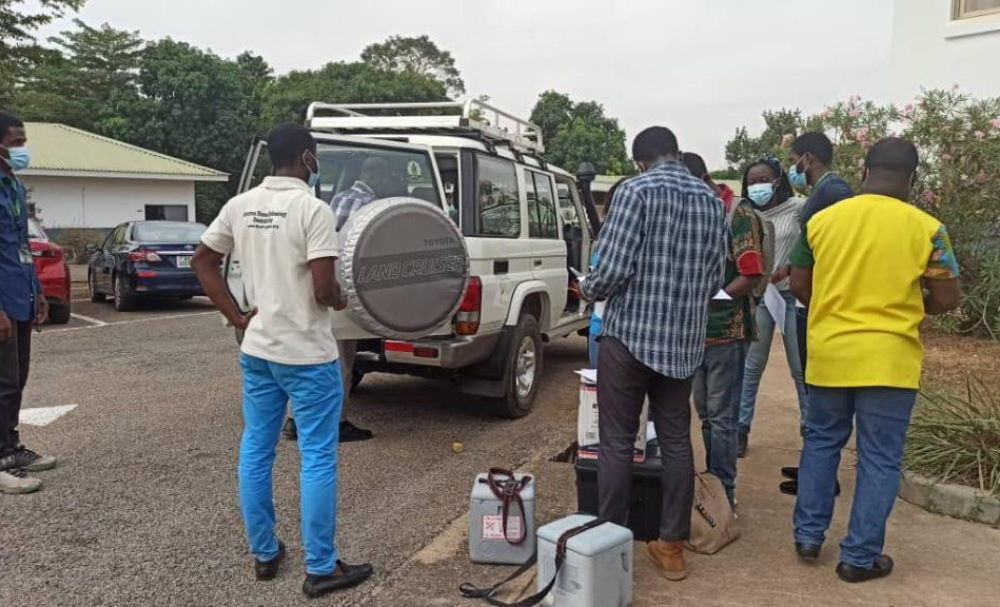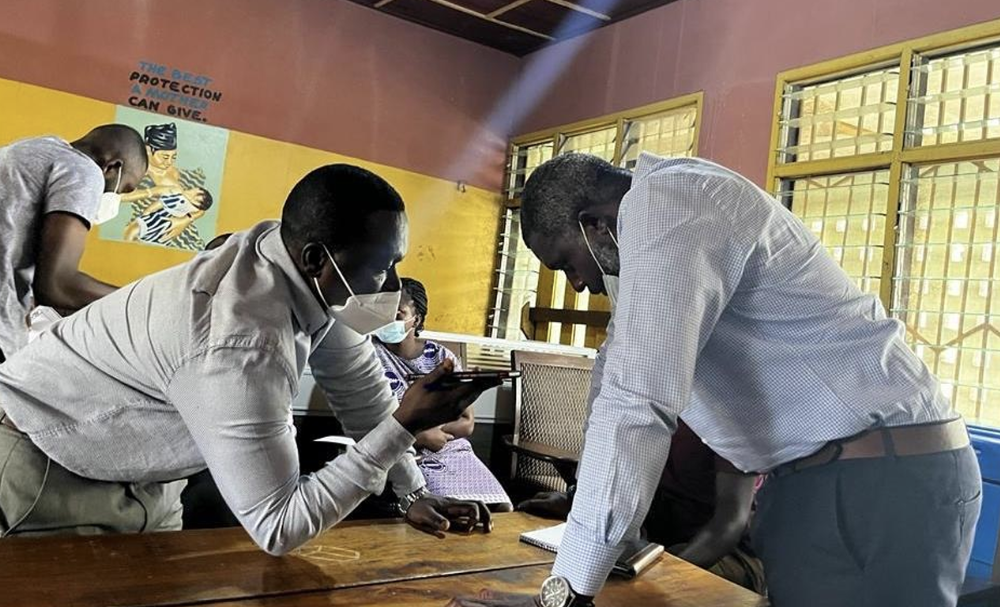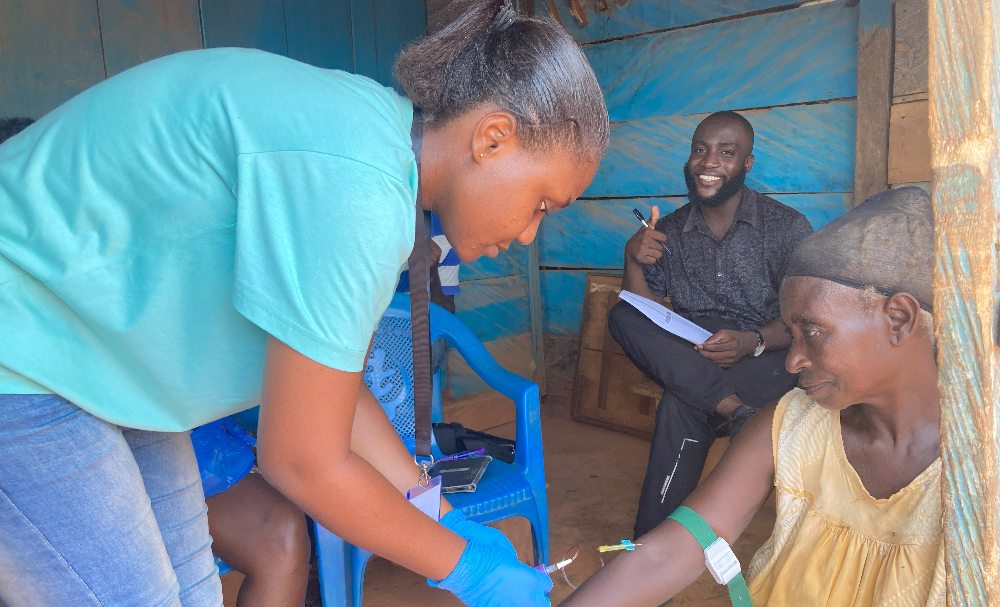ARTICLE AD
Serosurveys have expanded our understanding of infectious diseases in Africa, revealing the true burden of pathogens beyond reported outbreaks.
These studies have uncovered silent epidemics of otherwise never-reported pathogens of interest and provided additional insight into the burden of reported pathogens. This includes providing evidence of widespread dengue exposure among children and unexpected seroprevalence of Marburg virus disease.
Dr. Anthony Afum-Adjei Awuah has been at the forefront of these efforts, leveraging seroprevalence studies to bridge the gap between traditional outbreak responses and proactive pandemic preparedness.
 Researchers bring in samples collected from the field. (SerCoV - COVID-19 Seroprevalence Study) | Photo credit GHID-KCCR.
Researchers bring in samples collected from the field. (SerCoV - COVID-19 Seroprevalence Study) | Photo credit GHID-KCCR.
A research team in Ghana set out on a routine public health study in early 2021. Their goal was simple: collect blood samples from healthy individuals from randomly selected households from the country's northern, middle, and southern belts to test for COVID-19 antibodies.
The effort proved worthwhile. The research found 84.7% of people in Tamale, 43.9% in Kumasi, and 53.3% in Accra had been exposed to SARS-CoV-2, although the number of cases reported was extremely low. These findings countered global assumptions about the transmission of COVID-19 in Africa and helped shape Ghana’s national policy.
“For pandemic preparedness, seroprevalence surveys are invaluable,” says Dr. Anthony Afum-Adjei Awuah, Deputy Group Lead at Global Health and Infectious Diseases Research Group (GHID), Kumasi Centre for Collaborative Research in Tropical Medicine (KCCR), KNUST. “They give us a retrospective look at past exposures and provide an additional layer of support to the traditional surveillance system to improve pandemic preparedness.”
A brief history of seroprevalence studies
The beginnings of seroprevalence studies can be traced back to the early 20th century when scientists started drawing blood from patients to screen for antibodies, providing evidence of a prior infection. Once infected, a person’s immune system produces antibodies specific to the pathogen. Some of these antibodies can linger for years and can be used to determine if a person has been infected at any point with a pathogen, especially when it was undiagnosed. During World War II, they were used to track diseases like typhus and malaria in soldiers. In the 1980s, serosurveys played a crucial role in understanding the spread of HIV and some beneficial responses worldwide.
Over the years, seroprevalence studies have become important tools for mapping disease exposures, monitoring vaccine coverage, and identifying immunity gaps. Today, these surveys seek to expose hidden outbreaks and direct responses to avert future pandemics.
Beyond COVID-19
The Ghana work was only the beginning. Researchers quickly realized that serosurveys could uncover exposures not only to COVID-19 but also to a whole host of other infectious threats.
 Harvesting serum samples for storage and further processing | Photo credit GHID-KCCR.
Harvesting serum samples for storage and further processing | Photo credit GHID-KCCR.
Under the SERODEN study, blood samples drawn from Ghana, Senegal, and the Democratic Republic of Congo showed widespread exposure to Dengue virus. In Ghana, it was found that 36% of children in Tamale had already been exposed by age nine, compared to 5% percent in Kumasi and 18% in Accra.
“This means that in some parts of Africa, there is an increased risk of dengue infection especially among children,” Dr. Afum-Adjei Awuah mentions. “Understanding this helps us put a public health intervention in place and plan for potential vaccine rollouts.”
The Marburg Virus mystery
The most unsettling finding came from the SeroMARV study, which aimed to track exposure to the Marburg virus, a deadly hemorrhagic fever virus related to Ebola.
These severe viral infections cause extensive internal bleeding, high fever, and massive organ damage by disrupting the body's ability to regulate blood clotting and vascular integrity.
In July 2022, when Ghana faced its first-ever Marburg virus outbreak, three cases were confirmed in the Ashanti region, two of which were fatal. This impressed the need for proactive surveillance to detect and respond to emerging threats promptly.
Dr John Amuasi, Group lead for the GHID-KCCR and co-lead of The African coaLition for Epidemic Research, Response and Training (ALERRT), explained why there was a need to deploy the SeroMARV study.
“When the Ghana Health Service announced that there was a Marburg virus disease outbreak, the team sprang into action. Our inquiries with the support of the Ghana Health Service led us to believe the outbreak as we saw it might have been the tip of the iceberg.”
“We realized by deploying well-designed serosurveys, we could better appreciate what might have happened and its scale and therefore generate knowledge which would help Ghana be better prepared for future outbreaks,” he said.
 Dr John Amuasi working with Ghana Health Service on contact tracing during the Marburg outbreak in Ghana | Photo credit GHID-KCCR.
Dr John Amuasi working with Ghana Health Service on contact tracing during the Marburg outbreak in Ghana | Photo credit GHID-KCCR.
The initial findings suggested that there were individuals in the areas where these outbreaks occurred who had been previously exposed to the Marburg virus but did not show typical symptoms associated with the disease.
"Serological assays are not perfect," Dr. Afum-Adjei Awuah explains. "There is the need to address discordance with the immunological tools used to perform these serosurveys."
The researchers estimated that Marburg virus seroprevalence in Ghana was around 0.6%, with one sample testing positive for Crimean-Congo hemorrhagic fever virus, a widespread zoonotic disease caused by a tick-borne virus (Nairovirus). The findings suggested that while undetected Marburg transmission might be occurring, cross-reactivity in antibody tests could also distort the picture.
This tells us two things," Dr. Awuah says. "First, Marburg exposure might be broader than we think. Second, we need better diagnostic tools to confirm these findings."
 Drawing participant sample during SEROMARV study in the Adansi North District, Ashanti Region, Ghana | Photo credit GHID-KCCR.
Drawing participant sample during SEROMARV study in the Adansi North District, Ashanti Region, Ghana | Photo credit GHID-KCCR.
Strengthening disease surveillance
Seroprevalence studies wield the ability to identify hidden threats that can direct public health response before outbreaks occur.
“The advantage here is that if we look for antibodies against pathogens based on our understanding of immunology, we will better be able to tell if there has been any cause for worries,” Dr Afum-Adjei Awuah explains.
“Our work seeks to provide some understanding and guidance to identify transmission hotspots that otherwise our conventional surveillance system may miss.”
Researchers are trying to upscale activities through the SeroMarv Africa Plus Study, which will expand serosurveys to other African countries. In addition to determining the burden of past exposure to pathogens of interest, the study will also examine the role that genetics play in susceptibility to these infections.
Dr. Afum-Adjei Awuah believes that Africa must take charge of its disease surveillance. "If we truly want to prevent the next pandemic, we need to move from reactive to proactive strategies," he says. "Seroprevalence studies give us that opportunity."

DISCLAIMER: The Views, Comments, Opinions, Contributions and Statements made by Readers and Contributors on this platform do not necessarily represent the views or policy of Multimedia Group Limited.

 
 
 
 
 
 
 
 
 

 10 hours ago
4
10 hours ago
4 

